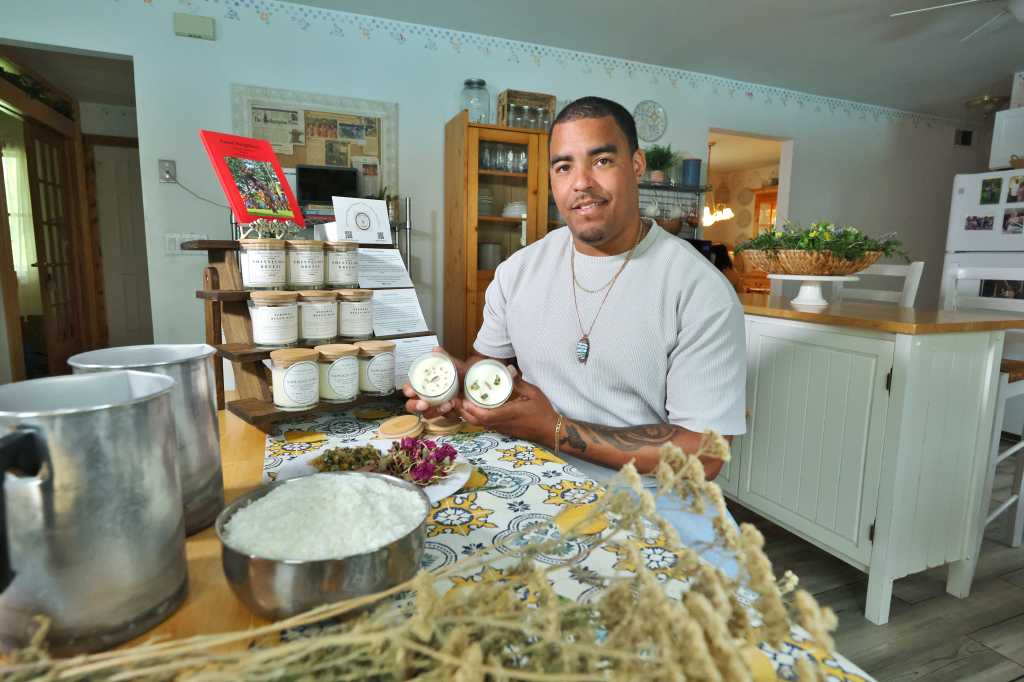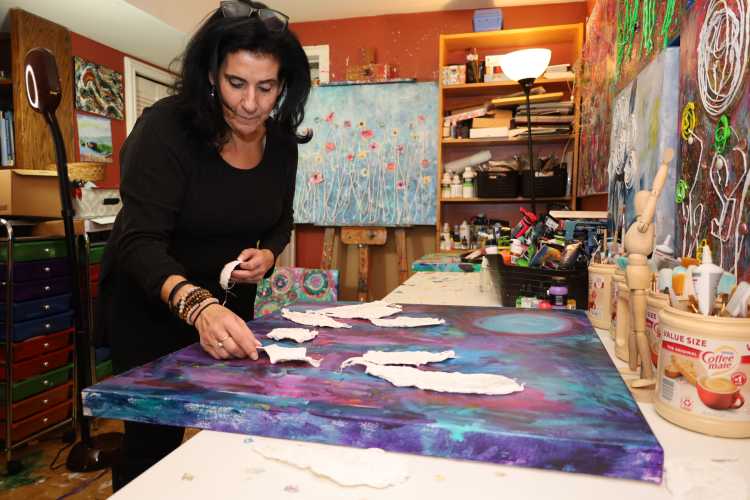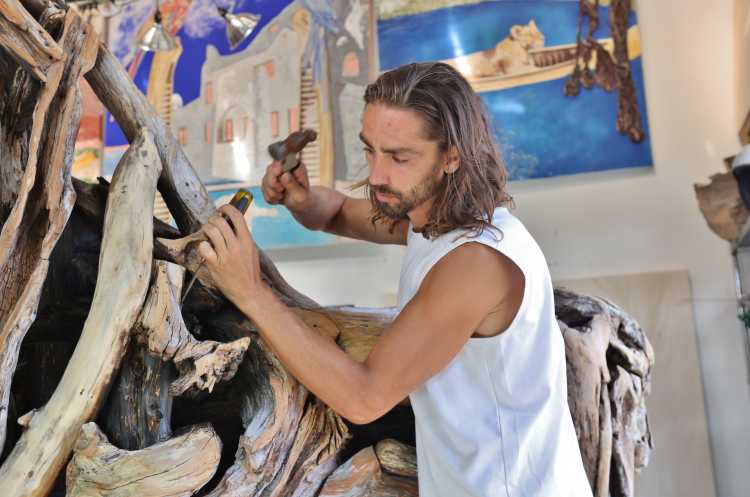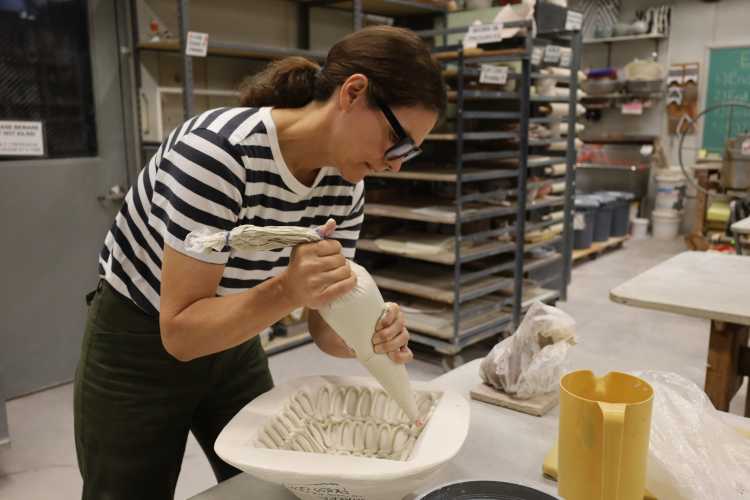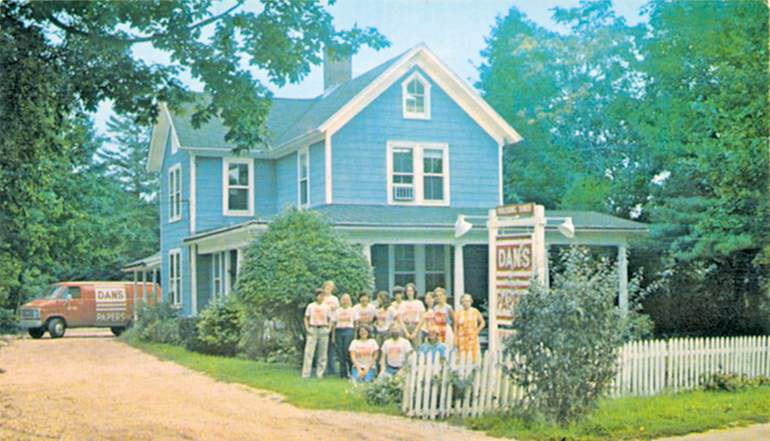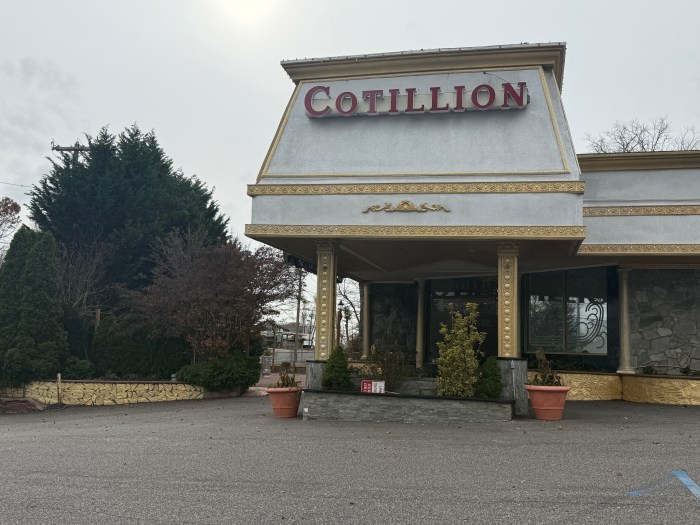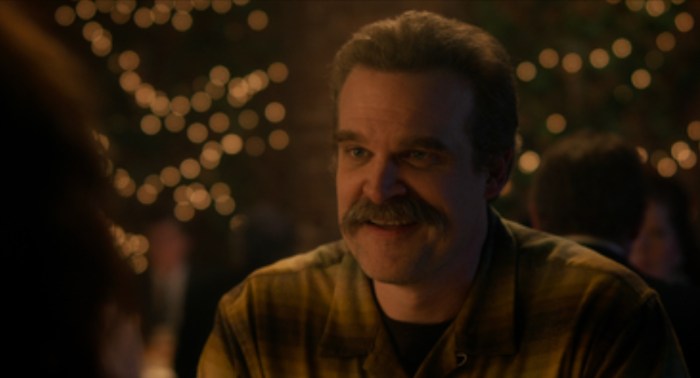Shane Weeks, a member of the Shinnecock Nation, says two scents stand out from his years growing up Shinnecock – the odor of sacred plants and the smell of fire. He grew up with the aroma of a wood stove, campfires and ceremonial burns at events like powwows, funerals and coming-of-age rituals.
“That scent brings me back to those times or that experience,” Weeks recalls. “Our ceremonies almost always include a fire on the ground. We collect wood and there’s a fire like a campfire.”
Weeks is now using fire in a different way to bring scents to people on and far beyond Shinnecock territory. In June of 2023, he launched Ohke Creations, a soy wax candle-making company named for the word in the Shinnecock dialect of the Algonquian language for “Earth,” which comes from the word for “mother.”
Weeks, 34, creates scents and candles designed to bring nature and a comforting glow indoors. “The feeling, the experience when you have that sensory understanding of where you are, your environment,” he says. “You have that fire going and the candle, the ceremonial fire.”
In addition to being a craftsman and businessman, Weeks is the author of Good Neighbors: A Shinnecock History From A Shinnecock Perspective, which he began writing in 2017 and published in March of 2022. He also is a traditional singer and dancer.
His Shinnecock name is “Bizhiki Nibauit,” which means “standing buffalo.”
The Shinnecock are a self-governing, federally recognized tribe and the Indigenous people of Southampton, whose territory stretches from Eastport to Sag Harbor, the Peconic Bay to the Atlantic Ocean.
The tribe includes about 1,700 members with about 700 living on their close-to-1,000 acres. The tribe also controls about 90 acres in Hampton Bays just west of the Shinnecock Canal.

the word for the Yellow Lily Flower, “Sebon,” and the word for earth, “Ohke.”Shannyn Weeks
The path to Candles
Weeks says he decided to begin making candles a little more than a year ago. “It’s something I thought about for a while. I wanted to dive into it and get it going,” he says. “I spent several months testing them, getting the scents, the wax, the fragrance ratio in order. I wanted to make something that in some way helped people connect to nature, to help people connect with the Earth.”
He learned by speaking to candle makers and watching candle-making videos, before spending almost four months making and testing candles, until he got the formula right. Weeks says he makes the candles by hand on Shinnecock territory. “I put my hands to each candle, each flower, each plant that goes in it,” Weeks says.
He uses wood wicks and soy wax, producing candles that burn for 24 to 32 hours. Customers include those who love the product or want to support BIPOC (Black, Indigenous, and people of color) businesses.
“People who love candles, who enjoy the ambiance,” he says. “People who want to connect more to nature. People have been saying they love the scent. They’re strong scents, but not overpowering. You notice it when you open the jar.”
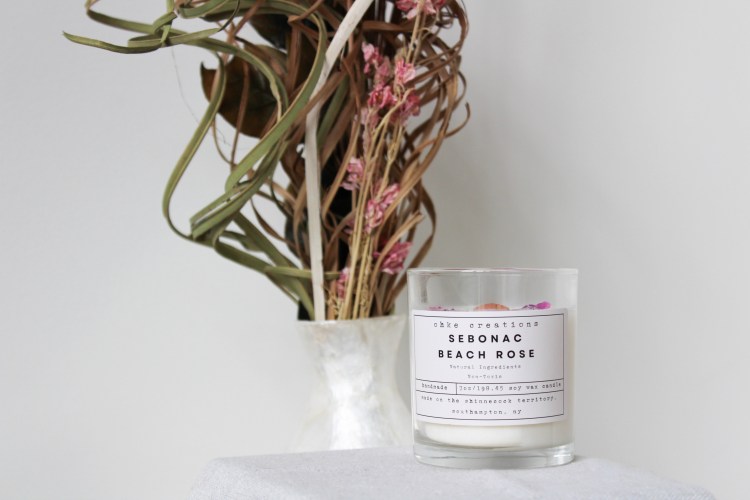
A scent by any other name Weeks named the candles to represent places named in the Shinnecock language, starting with the territory on the East End, such as Sebonac Beach Rose, Shinnecock Breeze and Napeague Citrus.
“All those places are still named in our language,” he says. “I wanted to incorporate some of the plants that our people use traditionally and include a little educational aspect.”
Each candle comes with a card with a story about its name and an explanation of the Shinnecocks’ uses of the flowers and plants in them. Shinnecock Breeze, for instance, has dandelions. While many see dandelions as weeds, Weeks remembers hearing elders talk about picking dandelions for dinner. “They would put them in their salad,” Weeks says. “Dandelion leaves and flowers are a staple ingredient for supper.”
Although he uses dandelions in that candle, the main scent comes from non-toxic fragrance oil. “It’s really the energy and the spirit of the plant,” Weeks says. “It gives off a little scent. If you just put the plant there without the oil, it wouldn’t.”
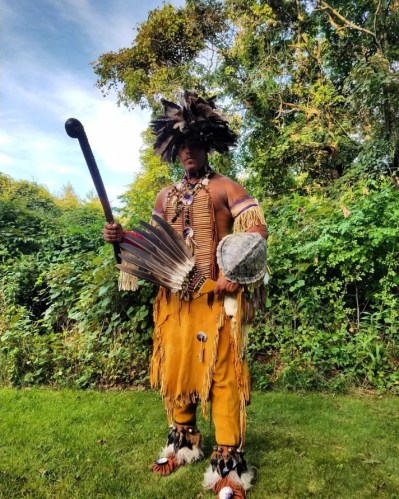
He sells online, on the reservation at shops including Shinnecock Smoke Shop and the Little Beach Harvest dispensary, as well as at Hildreth’s Home Goods store on Main Street in Southampton and several New York City stores. “I take them to various powwows and arts and craft events,” Weeks says.
As a member of the Shinnecock Nation, he says he also seeks to create an awareness of the tribe’s history and culture. “It’s providing a means for people to engage with our community, and have a better understanding of our history, our story,” Weeks says. “Part of who we are traditionally is connecting with the Earth.”
From Words to Wax
Weeks was a craftsman even before making candles. He began to make jewelry in 2006 at age 16. He created wampum jewelry, made from quahog clam shells, used as currency in the Colonial days, and beads and has since added gemstone jewelry.
He says he wrote the book about the Shinnecock Nation after asking “a major question” as to who he is as a Shinnecock. In the 19th and early 20th centuries, the federal government sought to erase indigenous identity, outlawing traditional Native American religious ceremonies and setting up Native American boarding schools that Native American children were required to attend, forcing them to speak English, study standard subjects, attend church and not allowing them to continue tribal traditions.
“Who are we as a Shinnecock community? A lot of our history, our culture, was outlawed until the 1970s,” Weeks continues. “The U.S. government deemed it illegal for Native Americans to practice our culture, speak our language, until the American Indian Movement (AIM) in the 1970s. It was the equivalent to the African-American civil rights movement.”
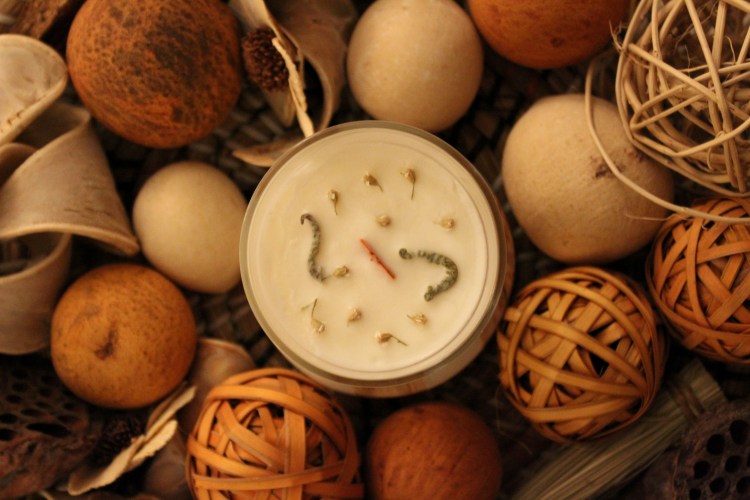
Growing Up Shinnecock
Shane Weeks grew up Shinnecock, but was also very connected to Southampton and beyond. His father Robin Weeks is a former dean of admissions at Nassau Community College, his mother Tracy Weeks works at the treasury department of a bank and his sister Shannyn Weeks works in translation project management, doing translations for companies.
“I grew up spending a lot of time on the land,” he says of the roughly 1,000 acres the Shinnecock control. “Our territory is sovereign. We had free range to go all across our territory.”
He serves on many committees and boards such as the Southampton Town Arts and Culture Committee, Watermill Center Community Fellowship, Graves Protection Warriors Society, Southampton Town / Shinnecock Nation Cultural Heritage Stewardship Committee and more.
Plus, he has worked in the film industry part-time for several years, primarily as art director, leadman and art assistant. He worked on Montauk, The Last Thing Mary Saw, Bravo’s Summer House and Amazon’s Metro Park Season 2.
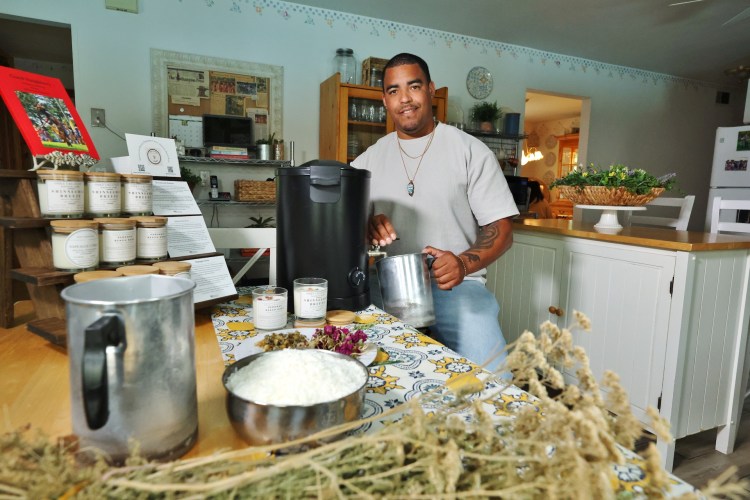
Weeks plans to grow his candle business beyond three scents, but for now is focusing on those. “Eventually, I will add more scents,” Weeks says. “I wanted to carry on with this for a while.”
He hopes to expand to soaps and lotions. As he branches out to more stores and sells online, he sees himself as making candles that spread light, scent and a little bit about Shinnecock culture and story.
“It’s one of those often overlooked sensory experiences that often has a lot of effect on how we engage with the world,” Weeks says of scented candles.
“When you have the ambiance of something pleasant to smell, you can really relax and start to experience the world in a more calm, relaxed way.”

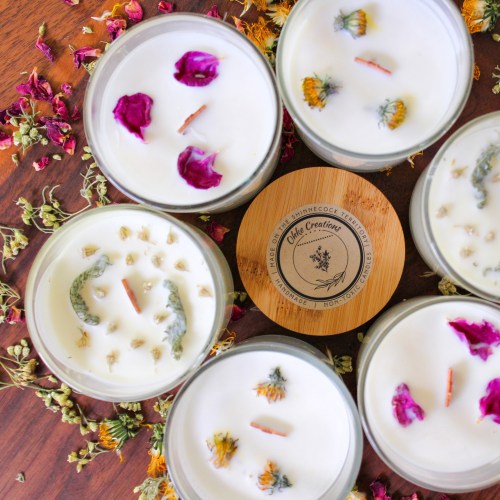
This article appeared in the Memorial Day weekend issue of Behind The Hedges. Click here to read the full digital edition. To read previous Master Craftsman columns click here.

